Experimental Research on Reinforced Concrete Columns Strengthened with Steel Jacket and Concrete Infill
Abstract
1. Introduction
2. Experimental Program
2.1. Test Specimens
2.2. Material Properties
2.3. Test Setup
3. Experimental Results and Specimen Behavior
3.1. Columns without Strengthening
3.2. Strengthened Columns
4. Analysis of the Test Results
5. Comparison with the Design Codes
5.1. The Design Codes Description
5.1.1. Eurocode 4
5.1.2. ANSI/AISC 360
5.1.3. DBJ/T13-51-2010
5.2. Results Discussion
6. Conclusions
Author Contributions
Funding
Institutional Review Board Statement
Informed Consent Statement
Data Availability Statement
Acknowledgments
Conflicts of Interest
References
- Johansson, M.; Gylltoft, K. Mechanical Behavior of Circular Steel–Concrete Composite Stub Columns. J. Struct. Eng. 2002, 128, 1073–1081. [Google Scholar] [CrossRef]
- Schneider, S.P. Axially Loaded Concrete-Filled Steel Tubes. J. Struct. Eng. 1998, 124, 1125–1138. [Google Scholar] [CrossRef]
- Roeder, C.W.; Cameron, B.; Brown, C.B. Composite Action in Concrete Filled Tubes. J. Struct. Eng. 1999, 125, 477–484. [Google Scholar] [CrossRef]
- Giakoumelis, G.; Lam, D. Axial capacity of circular concrete-filled tube columns. J. Constr. Steel Res. 2004, 60, 1049–1068. [Google Scholar] [CrossRef]
- Sakino, K.; Nakahara, H.; Morino, S.; Nishiyama, I. Behavior of Centrally Loaded Concrete-Filled Steel-Tube Short Columns. J. Struct. Eng. 2004, 130, 180–188. [Google Scholar] [CrossRef]
- Ellobody, E.; Young, B.; Lam, D. Behaviour of normal and high-strength concrete-filled compact steel tube circular stub columns. J. Constr. Steel Res. 2006, 62, 706–715. [Google Scholar] [CrossRef]
- Xiong, M.-X.; Xiong, D.-X.; Liew, J.R. Behaviour of steel tubular members infilled with ultra high-strength concrete. J. Constr. Steel Res. 2017, 138, 168–183. [Google Scholar] [CrossRef]
- Xiong, M.-X.; Xiong, D.-X.; Liew, J.R. Axial performance of short concrete filled steel tubes with high- and ultra-high- strength materials. Eng. Struct. 2017, 136, 494–510. [Google Scholar] [CrossRef]
- Yan, Y.; Xu, L.; Li, B.; Chi, Y.; Yu, M.; Zhou, K.; Song, Y. Axial behavior of ultra-high performance concrete (UHPC) filled stocky steel tubes with square sections. J. Constr. Steel Res. 2019, 158, 417–428. [Google Scholar] [CrossRef]
- Yu, Q.; Tao, Z.; Wu, Y.-X. Experimental behaviour of high performance concrete-filled steel tubular columns. Thin-Walled Struct. 2008, 46, 362–370. [Google Scholar] [CrossRef]
- Liew, J.R.; Xiong, M.; Xiong, D. Design of Concrete Filled Tubular Beam-columns with High-strength Steel and Concrete. Structures 2016, 8, 213–226. [Google Scholar] [CrossRef]
- Li, G.; Chen, B.; Yang, Z.; Feng, Y. Experimental and numerical behaviour of eccentrically loaded high-strength concrete filled high-strength square steel tube stub columns. Thin-Walled Struct. 2018, 127, 483–499. [Google Scholar] [CrossRef]
- Uy, B.; Tao, Z.; Han, L.-H. Behaviour of short and slender concrete-filled stainless steel tubular columns. J. Constr. Steel Res. 2011, 67, 360–378. [Google Scholar] [CrossRef]
- He, A.; Wang, F.; Zhao, O. Experimental and numerical studies of concrete-filled high-chromium stainless steel tube (CFHSST) stub columns. Thin-Walled Struct. 2019, 144, 106273. [Google Scholar] [CrossRef]
- He, A.; Zhao, O. Experimental and numerical investigations of concrete-filled stainless steel tube stub columns under axial partial compression. J. Constr. Steel Res. 2019, 158, 405–416. [Google Scholar] [CrossRef]
- Tao, Z.; Han, L.-H. Behaviour of concrete-filled double skin rectangular steel tubular beam–columns. J. Constr. Steel Res. 2006, 62, 631–646. [Google Scholar] [CrossRef]
- Han, L.-H.; Li, Y.-J.; Liao, F.-Y. Concrete-filled double skin steel tubular (CFDST) columns subjected to long-term sustained loading. Thin-Walled Struct. 2011, 49, 1534–1543. [Google Scholar] [CrossRef]
- Lia, W.; Cai, Y.X. Performance of CFDST stub columns using high-strength steel subjected to axial compression. Thin-Walled Struct. 2019, 141, 411–422. [Google Scholar] [CrossRef]
- Ye, Y.; Han, L.-H.; Sheehan, T.; Guo, Z.-X. Concrete-filled bimetallic tubes under axial compression: Experimental investigation. Thin-Walled Struct. 2016, 108, 321–332. [Google Scholar] [CrossRef]
- Kang, I.K.; Kim, S.H. Compressive Strength Testing of Hybrid Concrete-Filled Fiber-Reinforced Plastic Tubes Confined by Filament Winding. Appl. Sci. 2021, 11, 2900. [Google Scholar] [CrossRef]
- Han, L.-H.; Liu, W.; Yang, Y.-F. Behavior of thin walled steel tube confined concrete stub columns subjected to axial local compression. Thin-Walled Struct. 2008, 46, 155–164. [Google Scholar] [CrossRef]
- Han, L.-H.; Liu, W.; Yang, Y.-F. Behaviour of concrete-filled steel tubular stub columns subjected to axially local compression. J. Constr. Steel Res. 2008, 64, 377–387. [Google Scholar] [CrossRef]
- Han, L.H.; Liu, W.; Yang, Y.F. Design calculations on concrete-filled thin-walled steel tubes subjected to axially local com-pression. In Proceedings of the 12th International Symposium on Tubular Structures, Shanghai, China, 8–10 October 2008; pp. 85–91. [Google Scholar]
- Yang, Y.-F.; Han, L.-H. Experiments on rectangular concrete-filled steel tubes loaded axially on a partially stressed cross-sectional area. J. Constr. Steel Res. 2009, 65, 1617–1630. [Google Scholar] [CrossRef]
- Ding, F.-X.; Liu, J.; Liu, X.-M.; Yu, Z.-W.; Li, D.-W. Mechanical behavior of circular and square concrete filled steel tube stub columns under local compression. Thin-Walled Struct. 2015, 94, 155–166. [Google Scholar] [CrossRef]
- Priestley, N.M.J.; Seible, F.; Xiao, Y.; Verma, R. Steel jacket retrofitting of reinforced concrete bridge columns for enhanced shear strength—Part 1: Theoretical considerations and test design. ACI Struct. J. 1994, 91, 394–405. [Google Scholar]
- Priestley, N.M.J.; Seible, F.; Xiao, Y.; Verma, R. Steel jacket retrofitting of reinforced concrete bridge columns for enhanced shear strength—Part 2: Test results and comparison with theory. ACI Struct. J. 1994, 91, 537–551. [Google Scholar]
- Sakino, K.; Sun, Y. Steel jacketing for improvement of column strength and ductility. In Proceedings of the 12th World Conference on Earthquake Engineering, Auckland, New Zealand, 30 January–4 February 2000; p. 2525. [Google Scholar]
- Tsai, K.; Lin, M. Seismic jacketing of RC columns for enhanced axial load carrying performance. J. Chin. Inst. Eng. 2002, 25, 389–402. [Google Scholar] [CrossRef]
- Sezen, H.; Miller, E.A. Experimental Evaluation of Axial Behavior of Strengthened Circular Reinforced-Concrete Columns. J. Bridge Eng. 2011, 16, 238–247. [Google Scholar] [CrossRef]
- Ro, K.M.; Kim, M.S.; Lee, Y.H. Experimental Study on Seismic Retrofitting of Reinforced Concrete Frames Using Welded Concrete-Filled Steel Tubes. Appl. Sci. 2020, 10, 7061. [Google Scholar] [CrossRef]
- Ombres, L.; Verre, S. FRCM confined reinforced concrete columns: Experimental behavior and modeling. In Proceedings of the Symposium SP-345: Materials, Analysis, Structural Design and Applications of Textile Reinforced Concrete/Fabric Reinforced Cementitious Matrix. ACI Committee 549, Cincinnati, OH, USA, 20–24 October 2019; pp. 102–116. [Google Scholar]
- Testing Hardened Concrete Part 3: Compressive Strength of Test Specimens; EN 12390-3:2009 (2011); CEN-CENELEC Management Centre: Brussels, Belgium, 2011.
- Testing Hardened Concrete Part 13: Determination of Secant Modulus of Elasticity in Compression; EN 12390-13:2013; CEN-CENELEC Management Centre: Brussels, Belgium, 2013.
- Han, L.-H.; Li, W.; Bjorhovde, R. Developments and advanced applications of concrete-filled steel tubular (CFST) structures: Members. J. Constr. Steel Res. 2014, 100, 211–228. [Google Scholar] [CrossRef]
- Han, L.H.; Zhao, X.L.; Tao, Z. Tests and mechanics model of concrete filled SHS stub columns, columns and beam-columns. Steel Compos. Struct. 2001, 1, 51–74. [Google Scholar] [CrossRef]
- Eurocode 4. Design of Composite Steel and Concrete Structures Part 1-1: General Rules and Rules for Building; (EN 1994-1-1:2004); European Committee for Standardization: Brussels, Belgium, 2004. [Google Scholar]
- ANSI/AISC 360-10. Specification for Structural Steel Buildings; American Institute of Steel Construction: Chicago, IL, USA, 2010. [Google Scholar]
- Eurocode 3. Design of Steel Structures. Part 1-1: General Rules and Rules for Building; (EN 1993-1-1:2005); European Committee for Standardization: Brussels, Belgium, 2005. [Google Scholar]
- Chen, B.; Lai, Z.; Yan, Q.; Varma, A.H.; Yu, X. Experimental Behavior and Design of CFT-RC Short Columns Subjected to Concentric Axial Loading. J. Struct. Eng. 2017, 143, 04017148. [Google Scholar] [CrossRef]
- Hoang, A.L.; Fehling, E. A review and analysis of circular UHPC filled steel tube columns under axial loading. Struct. Eng. Mech. 2017, 61, 417–430. [Google Scholar] [CrossRef]
- Chiew, S.-P.; Cai, Y.-Q. Design of high-strength steel reinforced concrete columns—A Eurocode 4 approach. Steel Constr. 2018, 11, 306–314. [Google Scholar] [CrossRef]
- Wu, B.; Peng, C.W.; Zhao, X.Y.; Zhou, W.J. Axial loading tests of thin-walled circular steel tubes infilled with cast-inplace concrete and precast segments containing DCLs. Thin-Walled Struct. 2018, 127, 275–289. [Google Scholar] [CrossRef]
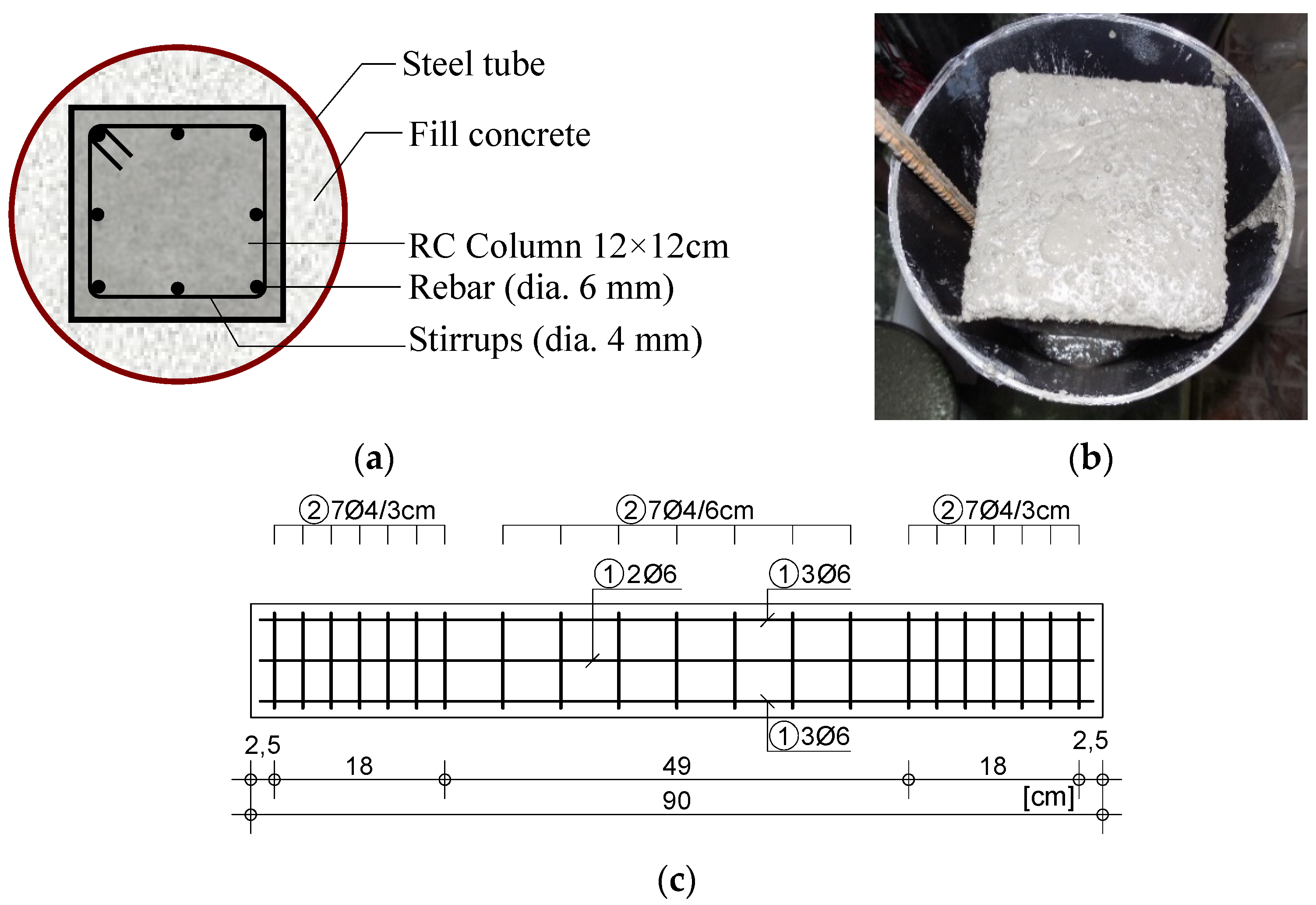
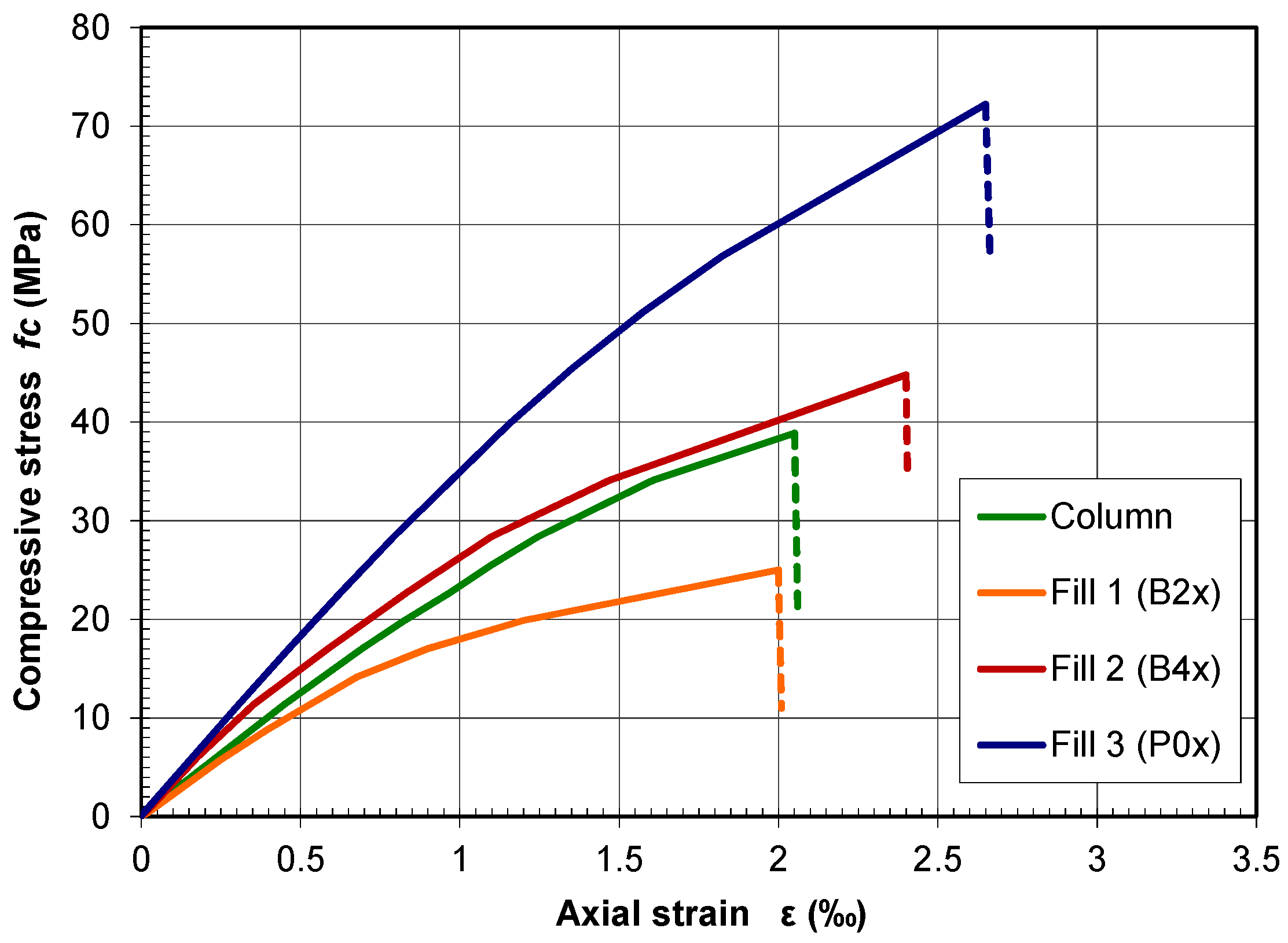
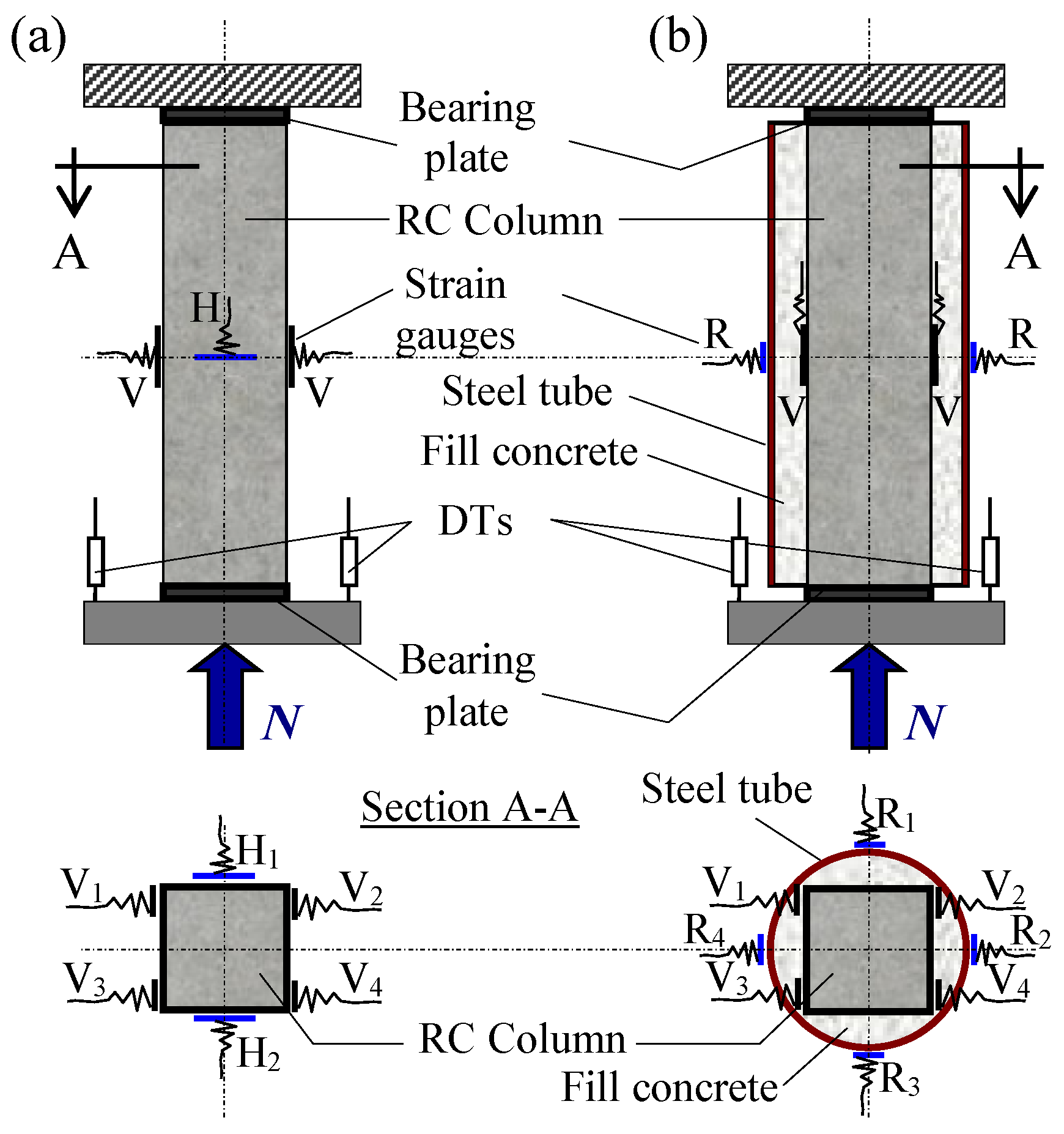
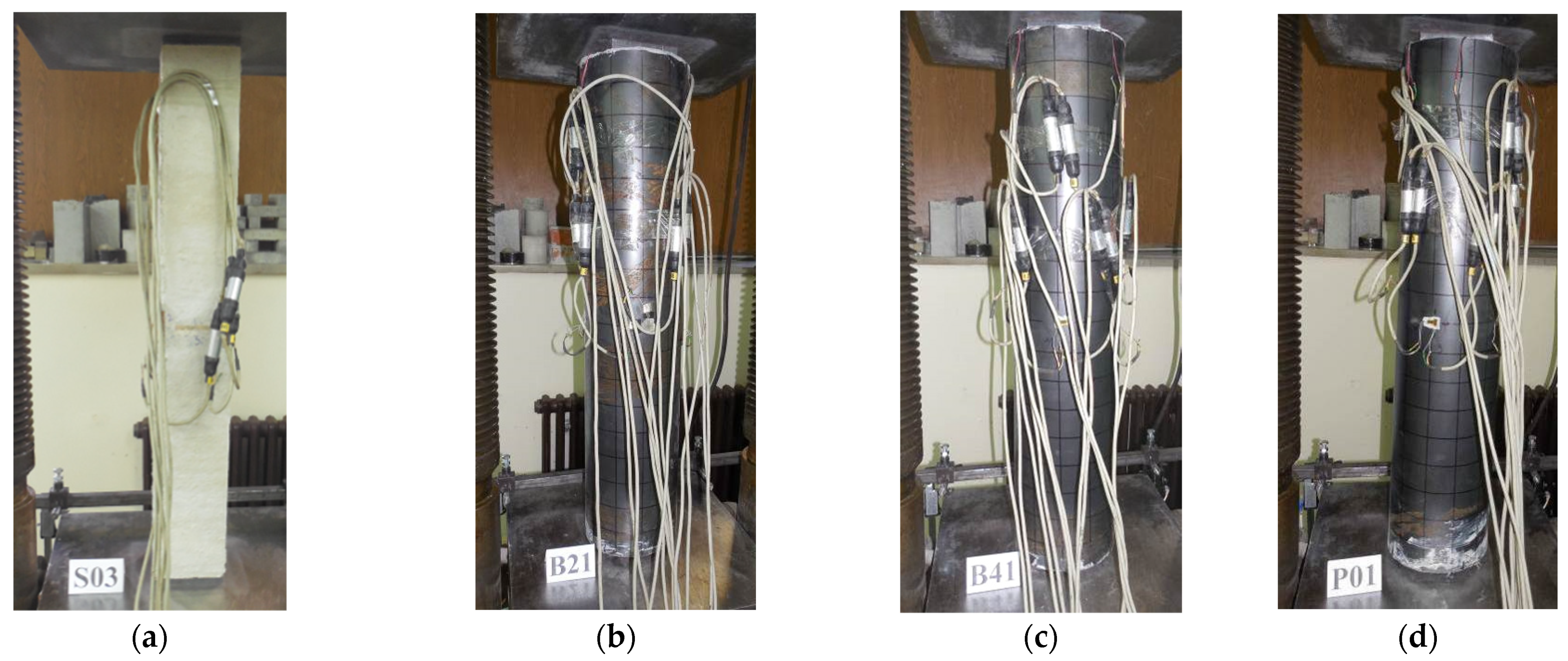

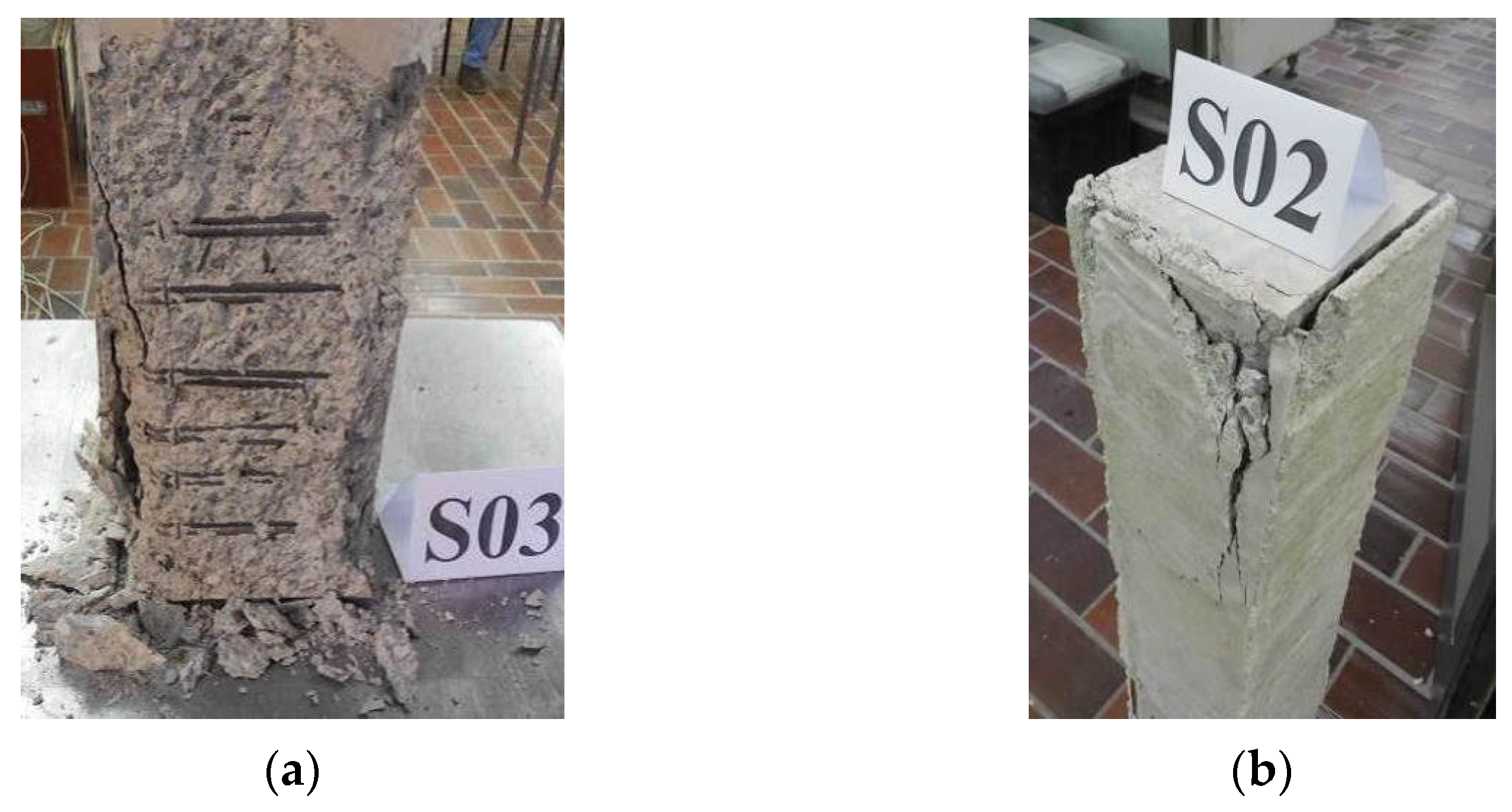

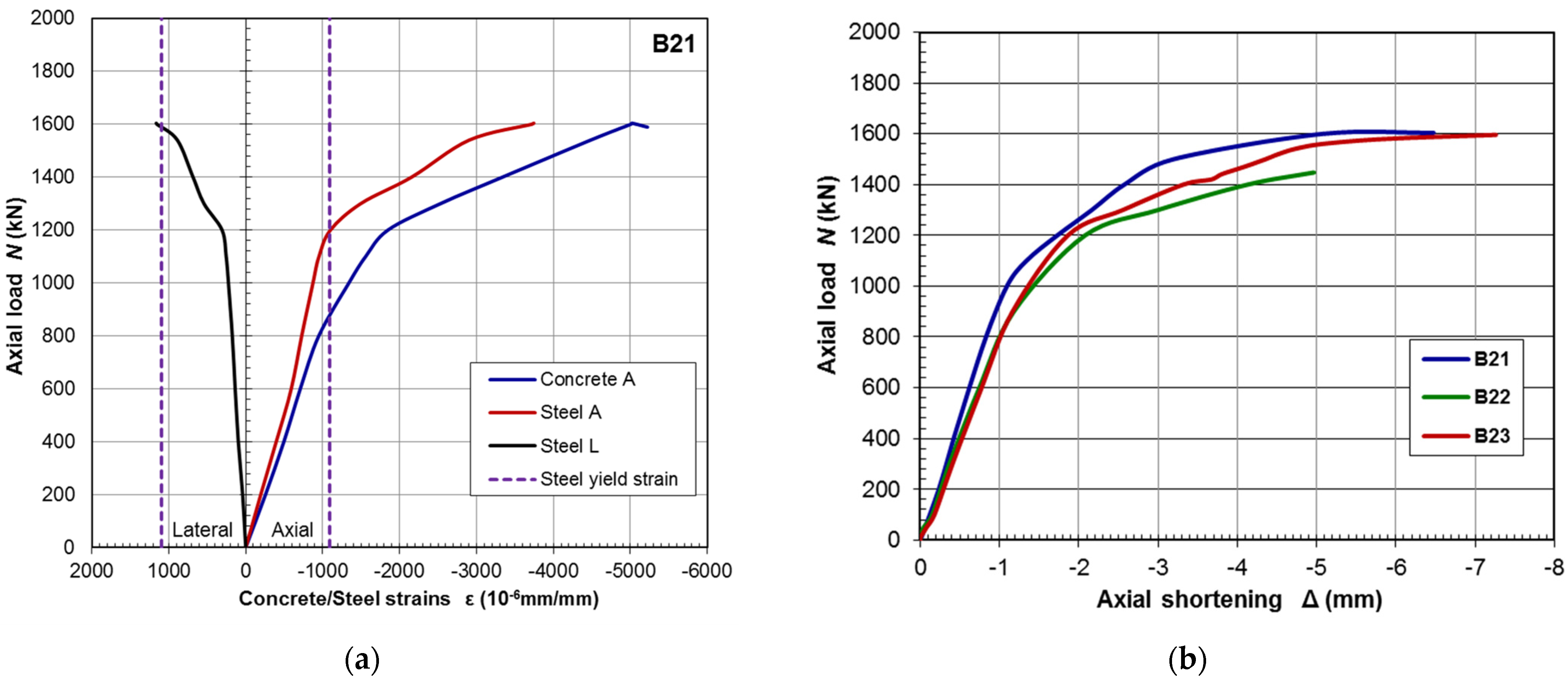
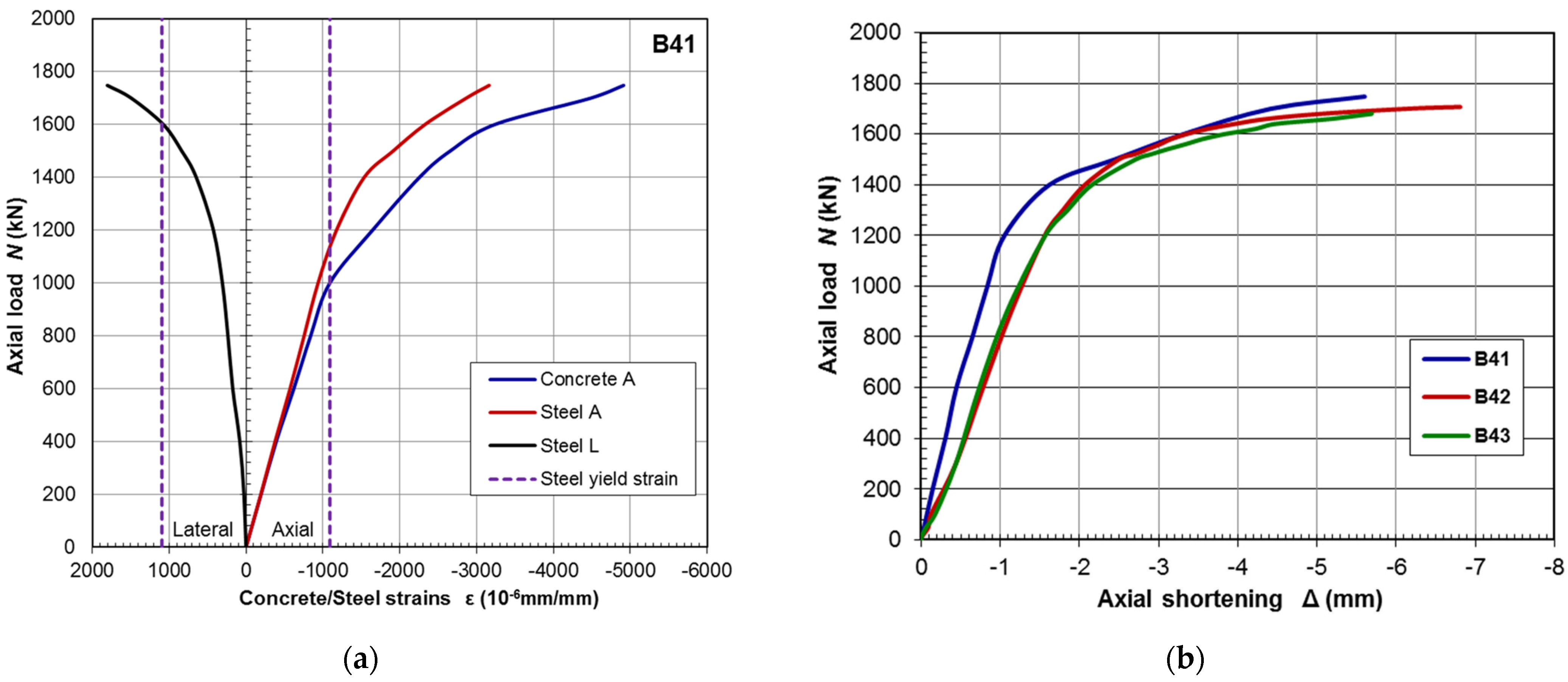

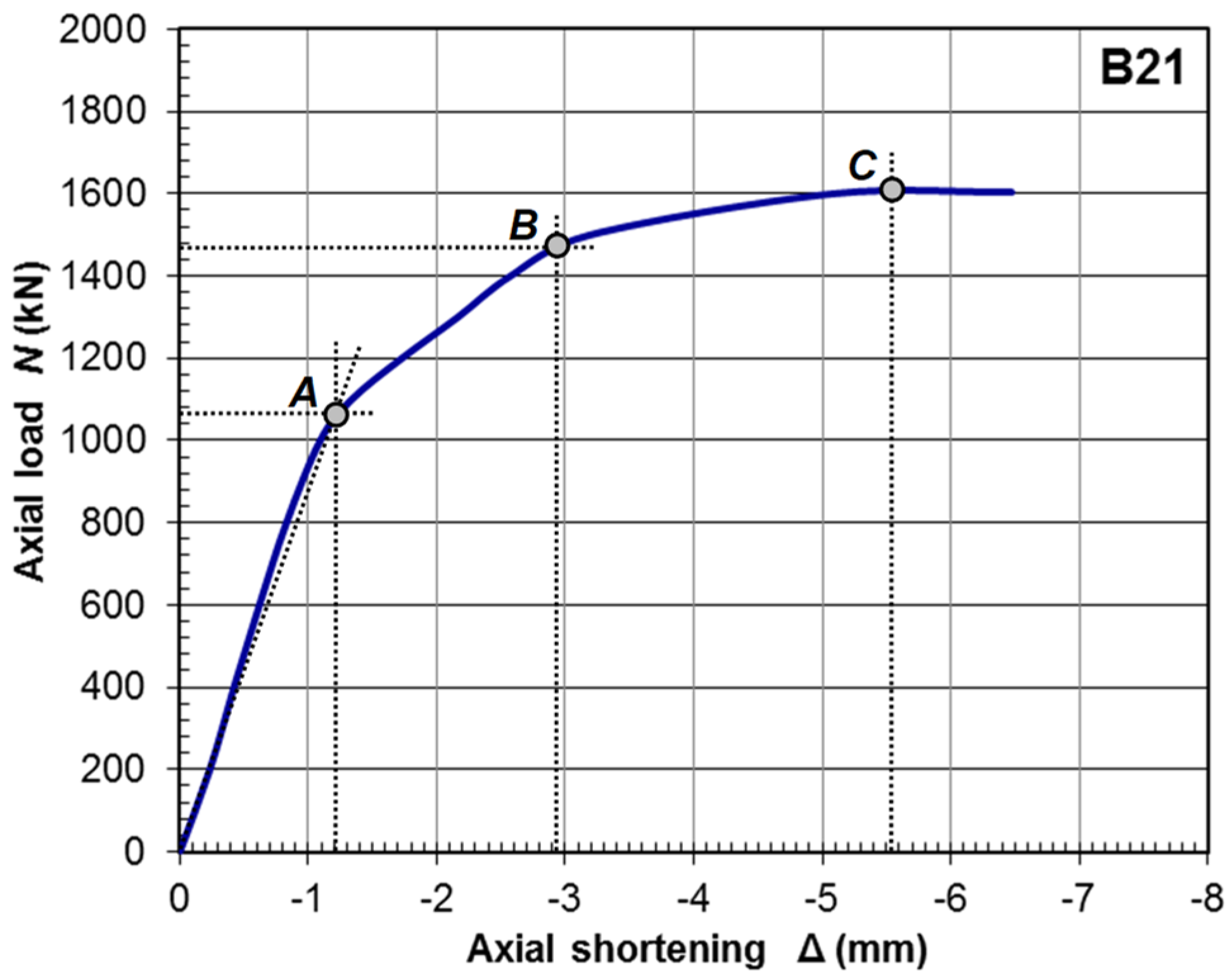
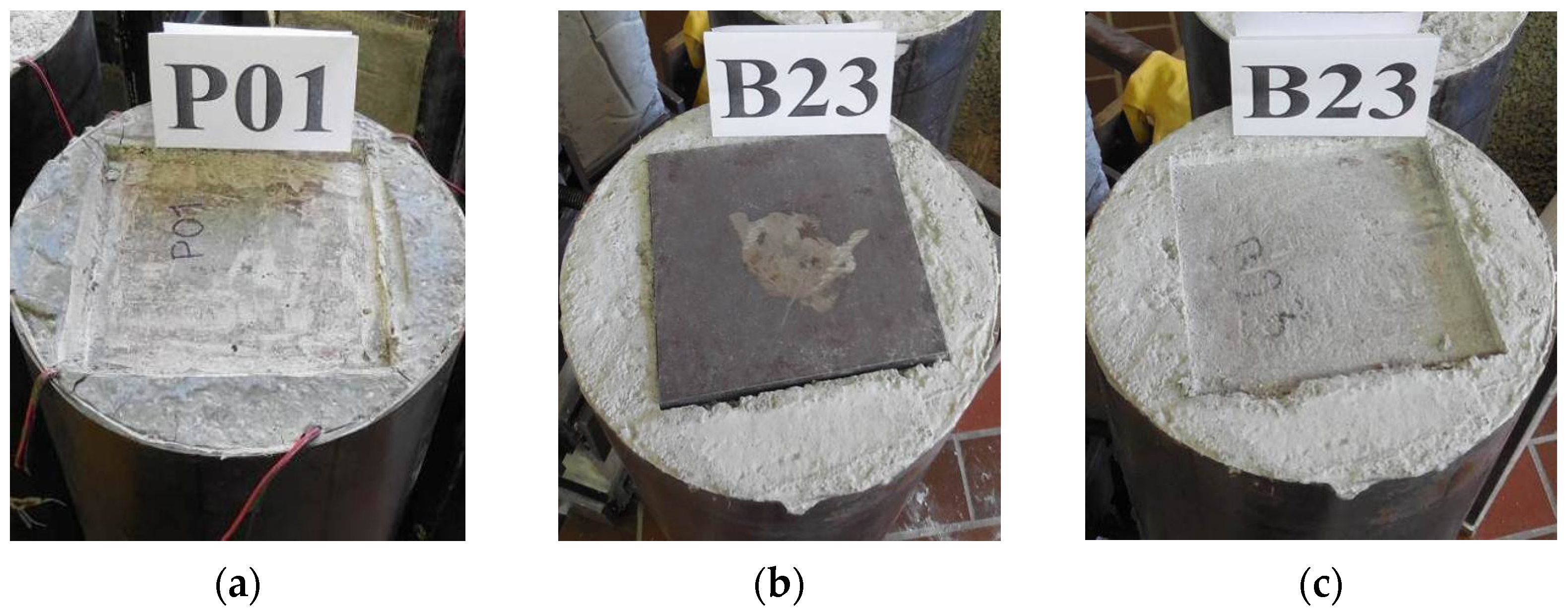
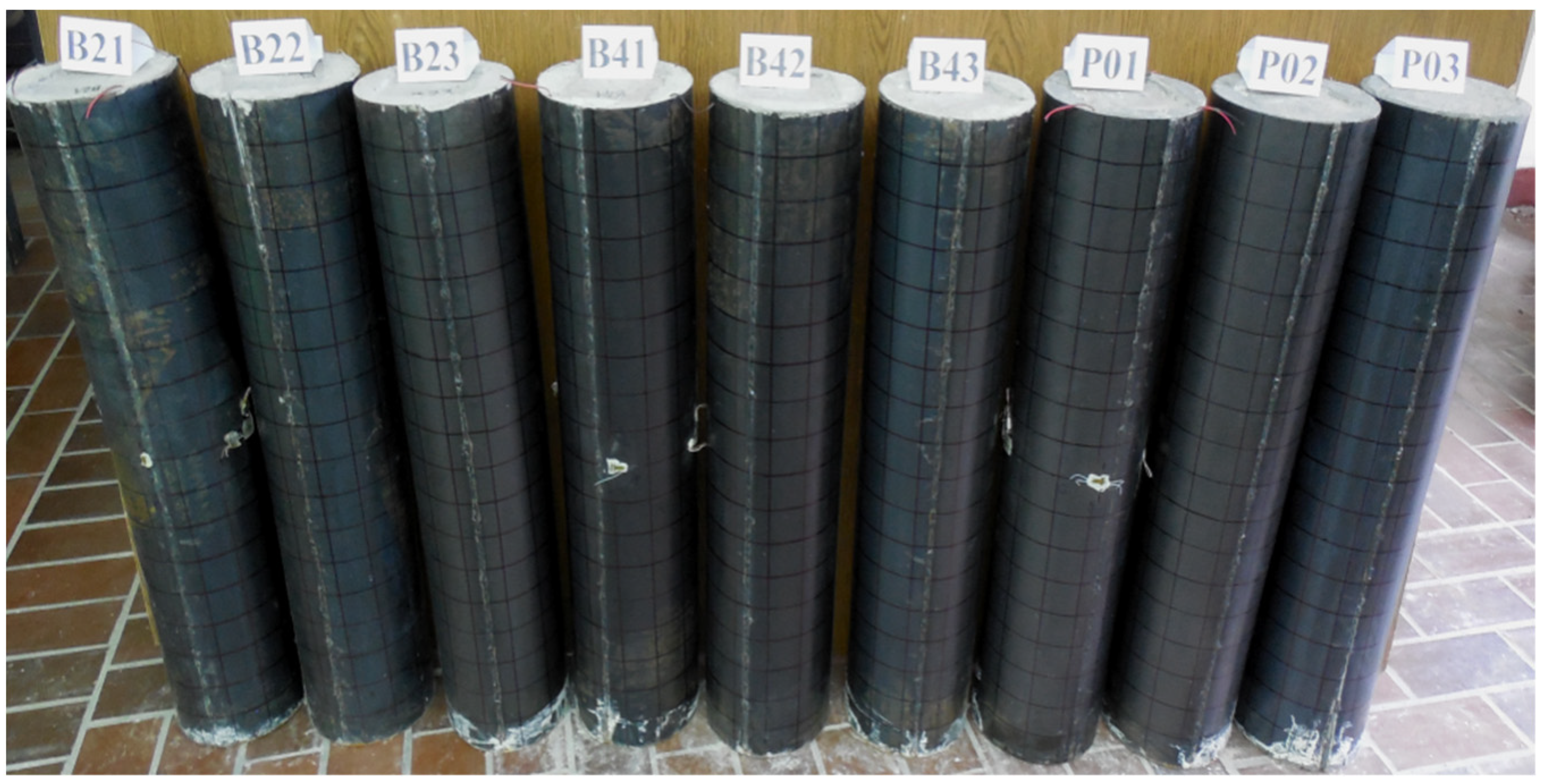
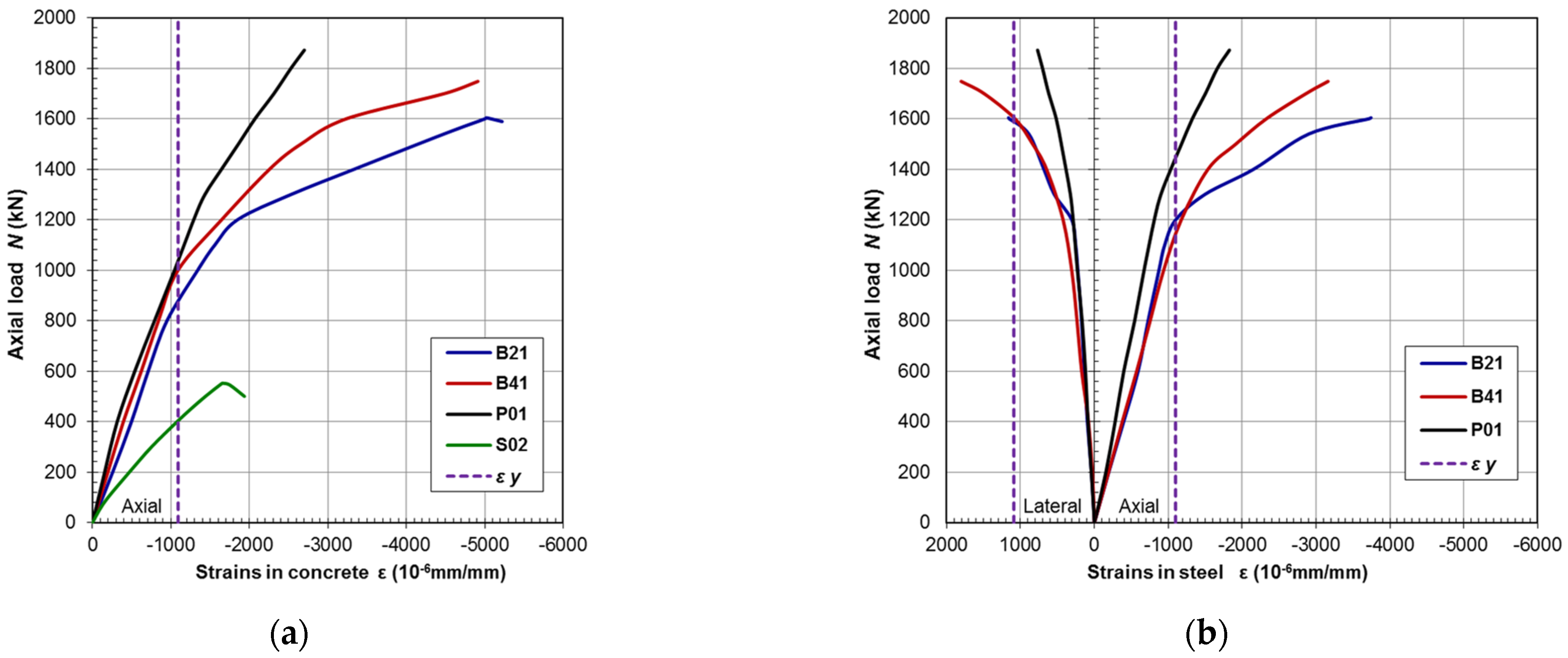
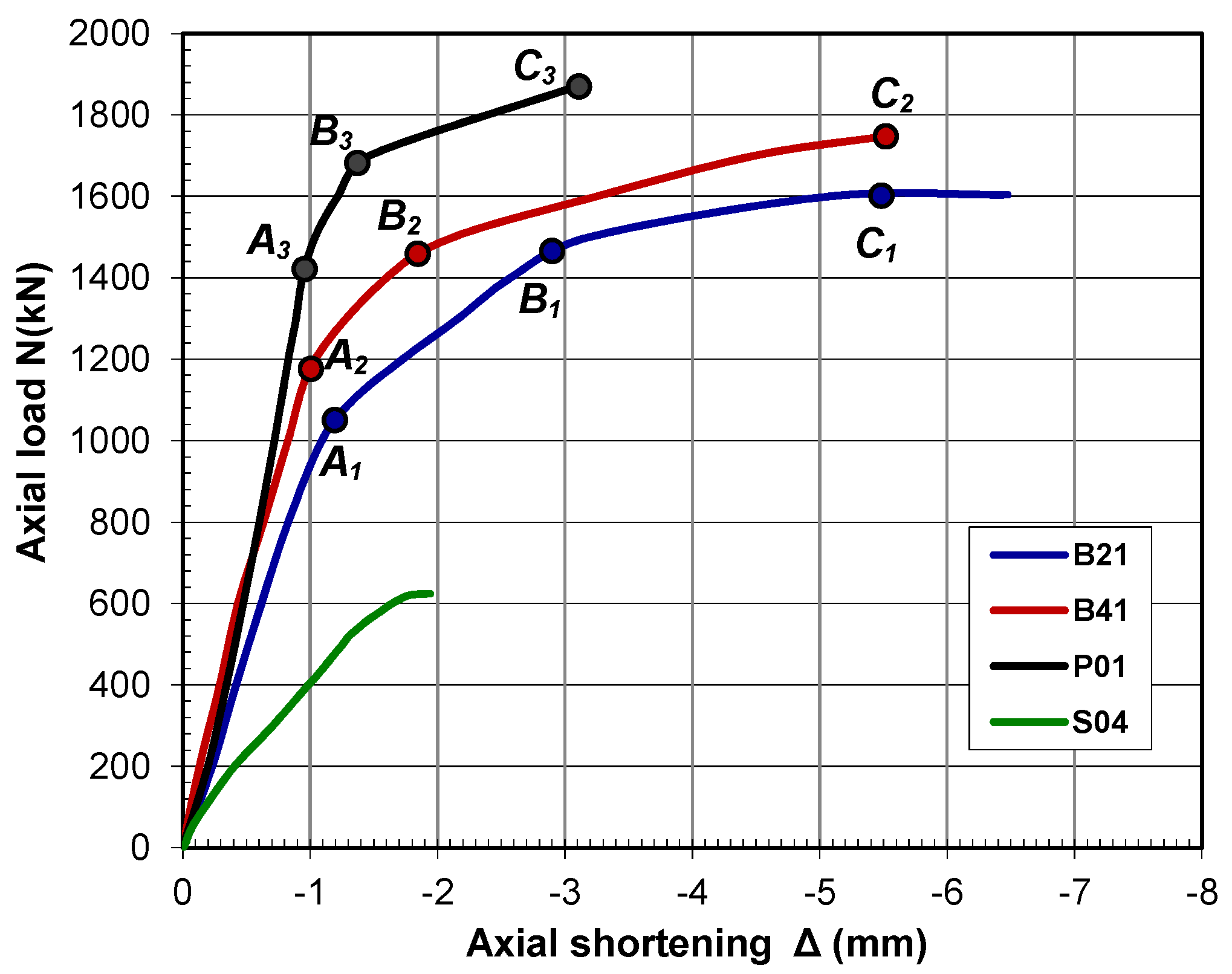
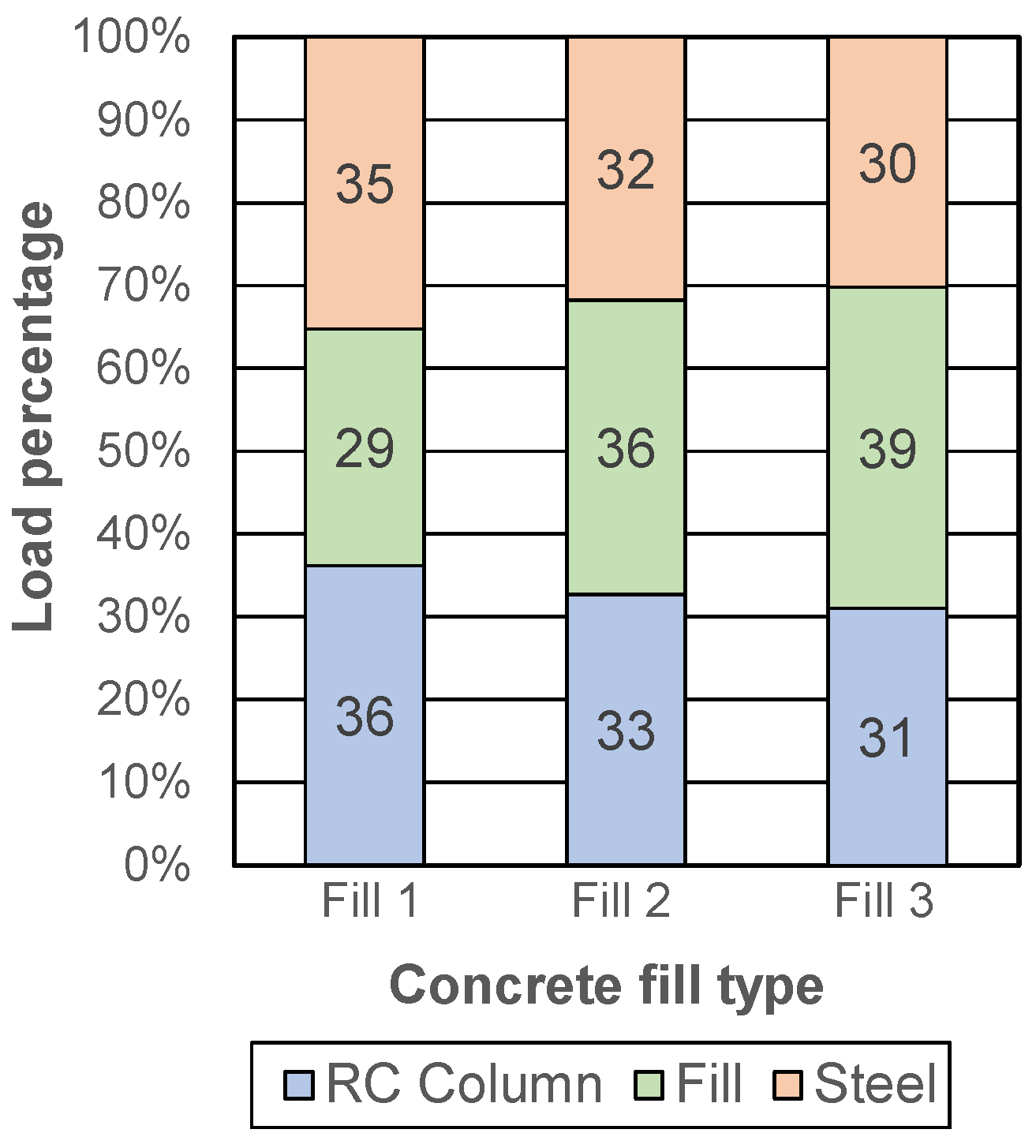
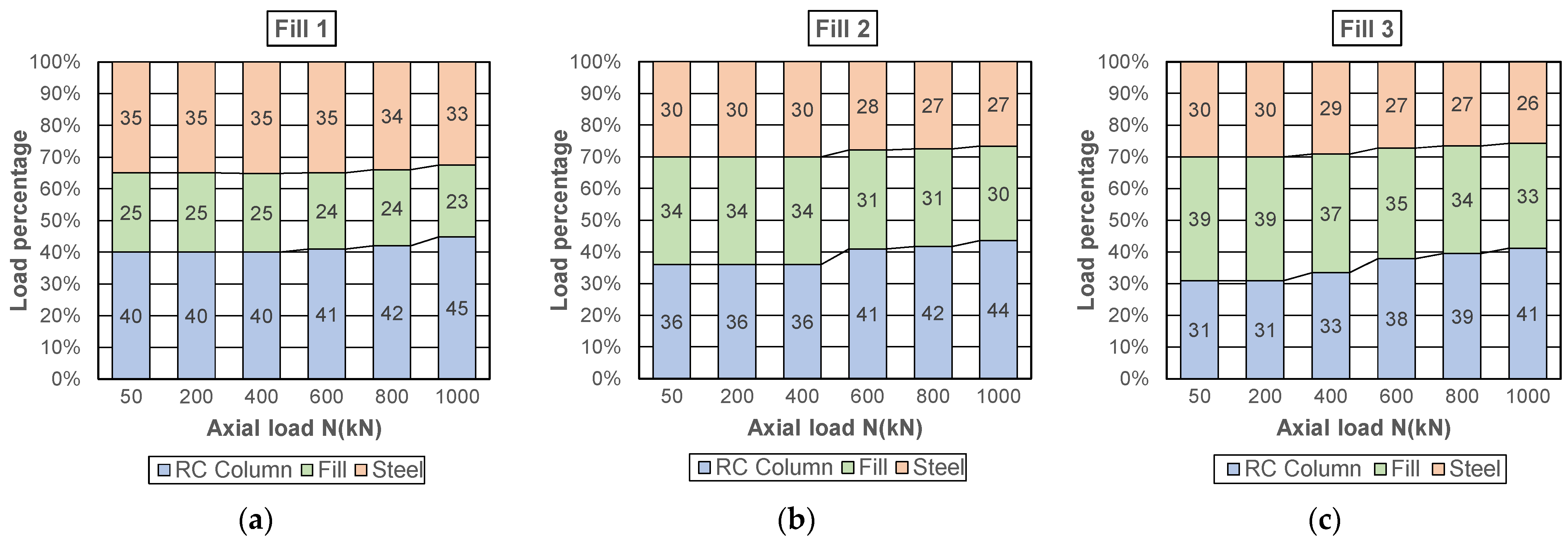
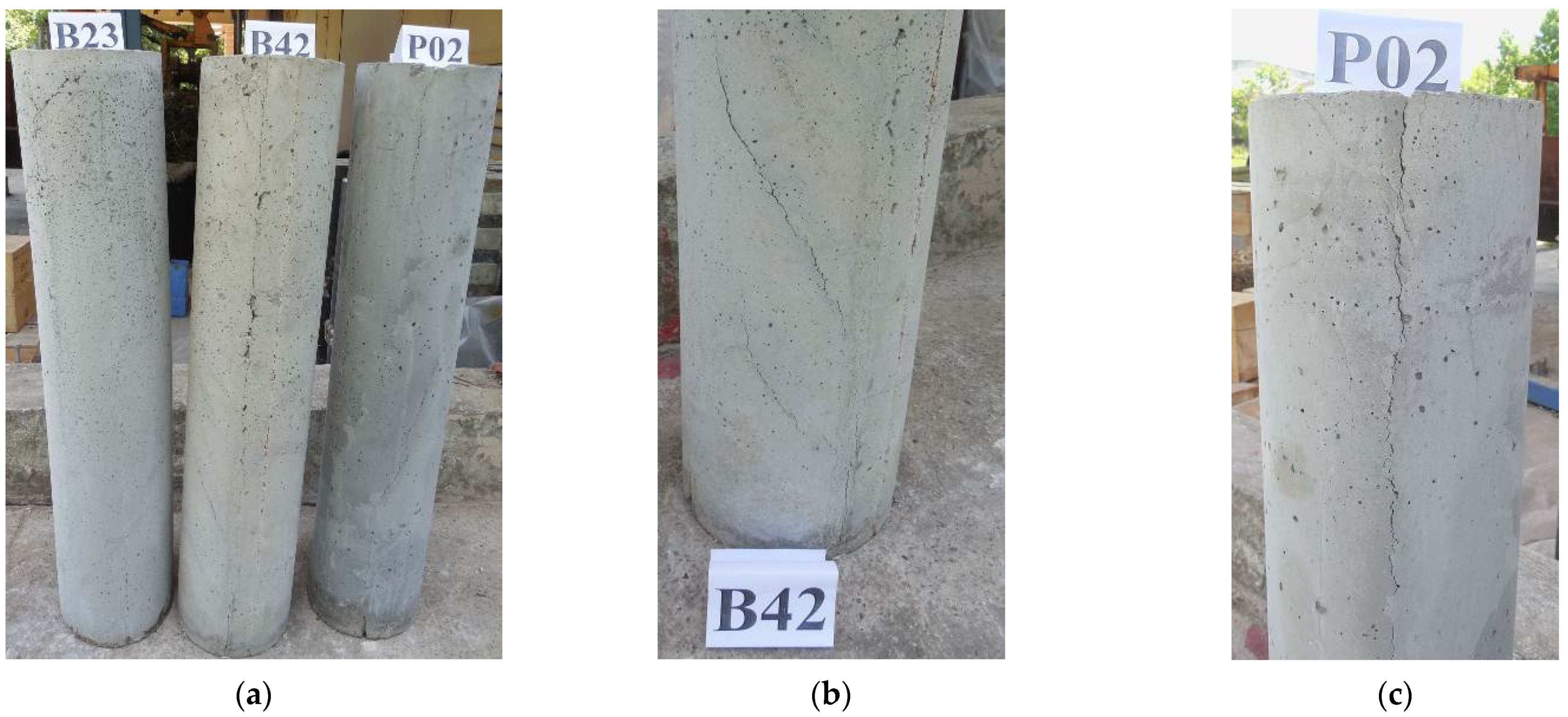
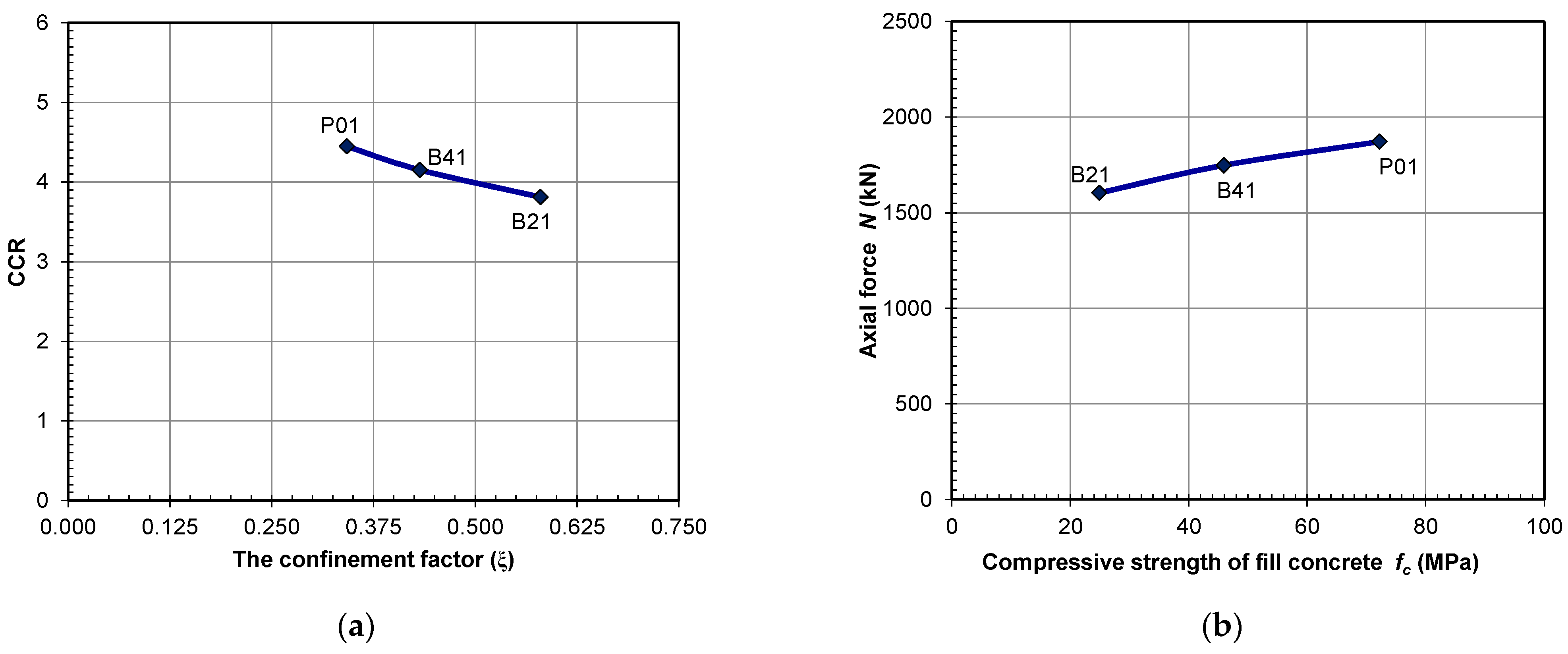
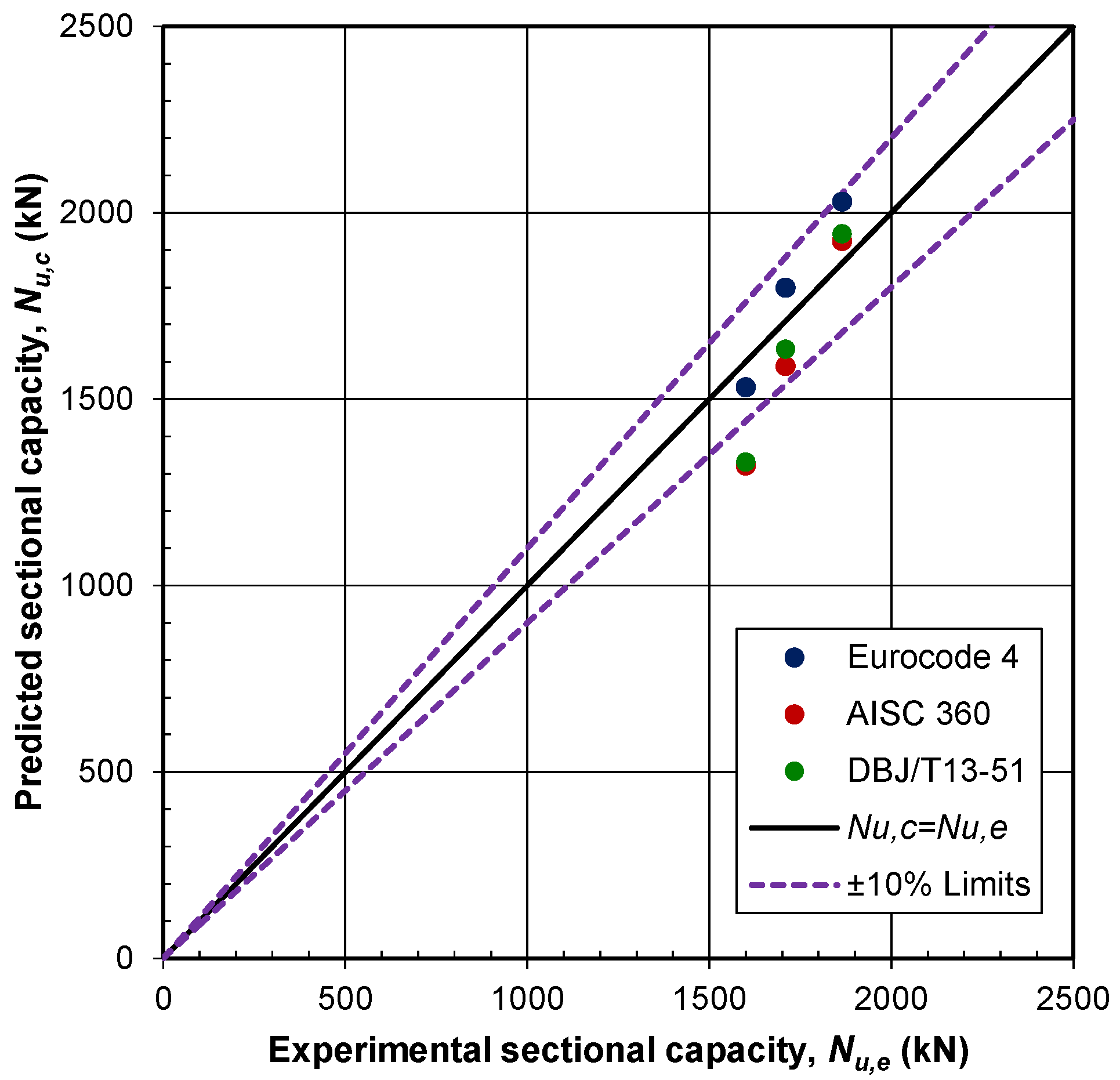
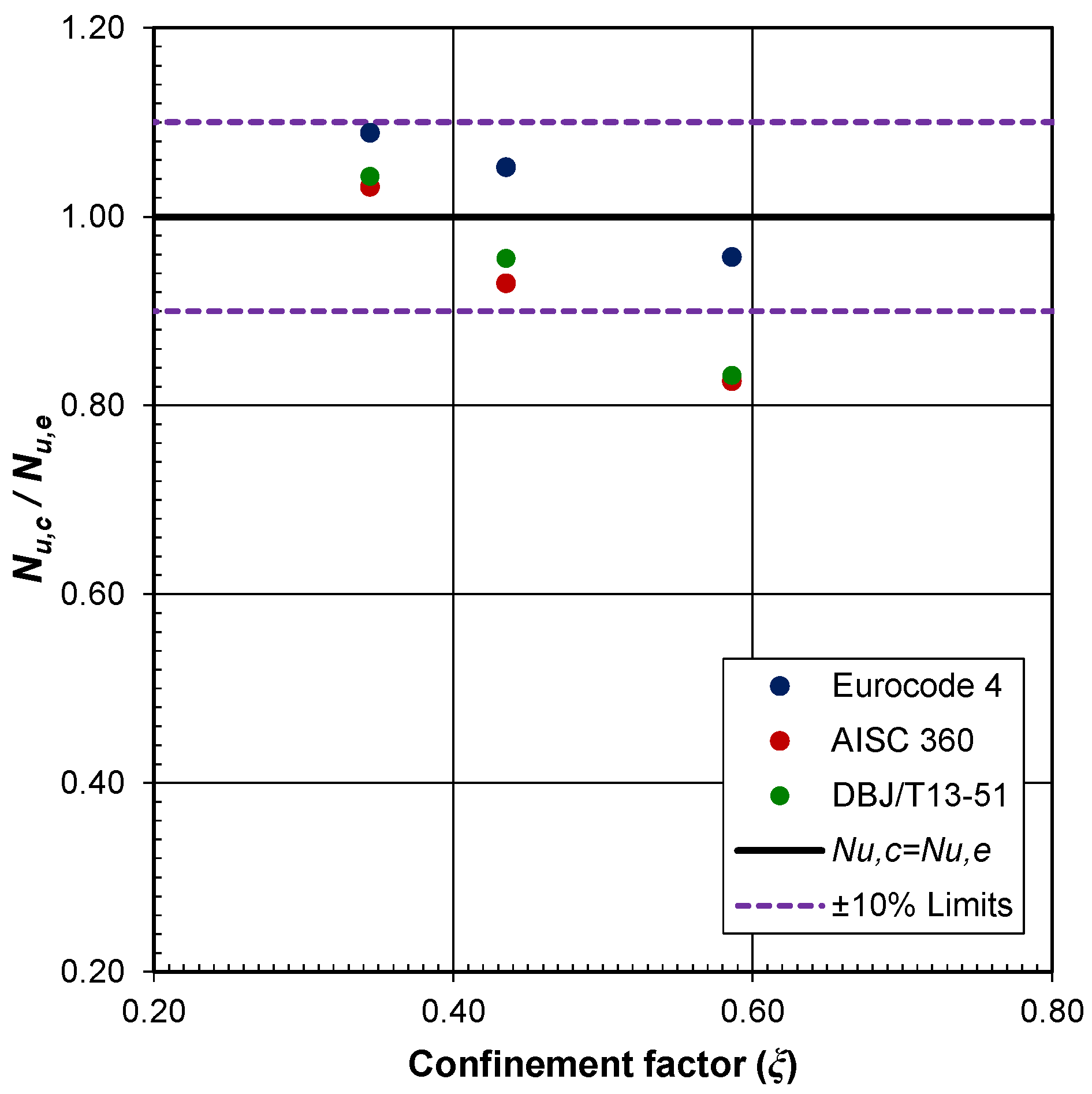
| No. | Specimen Label | B or D (cm) | t (mm) | L (cm) | D/t | ξ | Nu (kN) |
|---|---|---|---|---|---|---|---|
| 1 | S01 | 12 | - | 90 | - | - | 610 |
| 2 | S02 | 12 | - | 90 | - | - | 558 |
| 3 | S03 | 12 | - | 90 | - | - | 552 |
| 4 | S04 | 12 | - | 90 | - | - | 624 |
| 5 | S05 | 12 | - | 90 | - | - | 616 |
| 6 | B21 | 19.4 | 3 | 90 | 65 | 0.586 | 1604 |
| 7 | B22 | 19.4 | 3 | 90 | 65 | 0.586 | 1448 * |
| 8 | B23 | 19.4 | 3 | 90 | 65 | 0.586 | 1596 |
| 9 | B41 | 19.4 | 3 | 90 | 65 | 0.435 | 1748 |
| 10 | B42 | 19.4 | 3 | 90 | 65 | 0.435 | 1708 |
| 11 | B43 | 19.4 | 3 | 90 | 65 | 0.435 | 1672 |
| 12 | P01 | 19.4 | 3 | 90 | 65 | 0.344 | 1872 |
| 13 | P02 | 19.4 | 3 | 90 | 65 | 0.344 | 1856 |
| 14 | P03 | 19.4 | 3 | 90 | 65 | 0.344 | 1624 * |
| Label | Cement (kg/m3) | Fine Aggregate (kg/m3) | Coarse Aggregate (kg/m3) | Water (kg/m3) | Plasticizer (kg/m3) |
|---|---|---|---|---|---|
| Column–S0x | 443 | 466 | 1098 | 250 | - |
| Fill 1–B2x | 394 | 838 | 747 | 278 | 1.35 |
| Fill 2–B4x | 547 | 784 | 682 | 270 | 1.76 |
| Fill 3–P0x | Commercially available premade mixture | ||||
| Label | Class | fc (MPa) | fcu (MPa) | fct (MPa) | fck (MPa) | Ec (GPa) | υ (−) | ρ (kg/m3) |
|---|---|---|---|---|---|---|---|---|
| Column–S0x | C35/45 | 38.6 | 50.7 | 2.29 | 32.8 | 27.4 | 0.16 | 2229 |
| Fill 1–B2x | C20/25 | 24.9 | 28.3 | 1.47 | 18.9 | 23.3 | 0.17 | 2138 |
| Fill 2–B4x | C40/50 | 45.9 | 58.4 | 2.49 | 37.5 | 32.1 | 0.18 | 2211 |
| Fill 3–P0x | C70/85 | 72.2 | 90.0 | 3.70 | 56.5 | 36.8 | 0.18 | 2305 |
| Control Group | Fill 1 | Fill 2 | Fill 3 | |
|---|---|---|---|---|
| S0x | B2x | B4x | P0x | |
| Nu,exp (kN) | 592 | 1600 | 1709.3 | 1864 |
| Sn (kN) | 36.7 | 5.66 | 38.02 | 11.3 |
| COV (%) | 6.2 | 0.35 | 2.2 | 0.6 |
| ks (−) | – | 2.7 | 2.9 | 3.2 |
| Label | Nu,e | Nu,EC4 | Nu,EC4/Nu,e | Nu,AISC | Nu,AISC/Nu,e | Nu,DBJ | Nu,DBJ/Nu,e |
|---|---|---|---|---|---|---|---|
| Column–S0x | 1600.0 | 1531.6 | 0.957 | 1321.2 | 0.826 | 1330.9 | 0.832 |
| Fill 1–B2x | 1709.3 | 1798.9 | 1.052 | 1588.5 | 0.929 | 1633.8 | 0.956 |
| Fill 2–B4x | 1864.0 | 2029.5 | 1.089 | 1923.3 | 1.032 | 1943.4 | 1.043 |
| Fill 3–P0x | 1600.0 | 1531.6 | 0.957 | 1321.2 | 0.826 | 1330.9 | 0.832 |
Publisher’s Note: MDPI stays neutral with regard to jurisdictional claims in published maps and institutional affiliations. |
© 2021 by the authors. Licensee MDPI, Basel, Switzerland. This article is an open access article distributed under the terms and conditions of the Creative Commons Attribution (CC BY) license (https://creativecommons.org/licenses/by/4.0/).
Share and Cite
Landović, A.; Bešević, M. Experimental Research on Reinforced Concrete Columns Strengthened with Steel Jacket and Concrete Infill. Appl. Sci. 2021, 11, 4043. https://doi.org/10.3390/app11094043
Landović A, Bešević M. Experimental Research on Reinforced Concrete Columns Strengthened with Steel Jacket and Concrete Infill. Applied Sciences. 2021; 11(9):4043. https://doi.org/10.3390/app11094043
Chicago/Turabian StyleLandović, Aleksandar, and Miroslav Bešević. 2021. "Experimental Research on Reinforced Concrete Columns Strengthened with Steel Jacket and Concrete Infill" Applied Sciences 11, no. 9: 4043. https://doi.org/10.3390/app11094043
APA StyleLandović, A., & Bešević, M. (2021). Experimental Research on Reinforced Concrete Columns Strengthened with Steel Jacket and Concrete Infill. Applied Sciences, 11(9), 4043. https://doi.org/10.3390/app11094043






